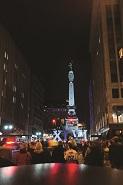
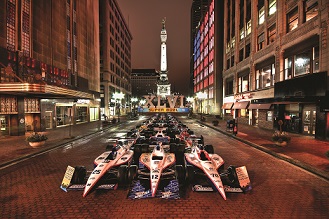
Something I was unaware of until 2011 when I accepted a position with Visit Indy, the official sales and marketing organization for Indianapolis charged with driving tourism through meetings, events and leisure travel, was that Indy’s sports initiative that ultimately led to hosting the Super Bowl began four decades ago, thanks to a group of civic leaders with a great vision. In the 1970s, former Senator and then Mayor Richard Lugar pulled together a group of city visionaries to develop a strategy to use sports as an economic driver to develop Indianapolis. At that time, the city only woke up one day a year to host the Indy 500; otherwise, it was a sleepy town with little tourism.
Laying the Groundwork for Change
The plan that would change that had three major components: build sports facilities and hotels downtown as opposed to in the suburbs, host sporting events to bring visitors to the city, and attract governing bodies to relocate their headquarters to Indy. We will first describe how the three-part initiative unfolded, and then explain the ways we calculated its success.
Building for the Future
In 1974, Market Square Arena was built in the heart of downtown for the Indiana Pacers. Then in 1984, without even having a professional NFL team, Indy built the Hoosier Dome, also in the heart of the city, and attracted the Colts from Baltimore in a still infamous overnight move.
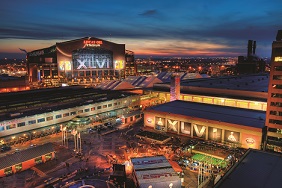 In 1979, the Indiana Sports Corp was founded as the nation’s first sports commission to attract events to the area. Having this premier institution (which is still in existence) literally a field goal kick away from Visit Indy’s offices allows for effective collaboration between the leadership and staff of both organizations. The NCAA national headquarters are also conveniently located within walking distance of both the ISC and Visit Indy.
In 1979, the Indiana Sports Corp was founded as the nation’s first sports commission to attract events to the area. Having this premier institution (which is still in existence) literally a field goal kick away from Visit Indy’s offices allows for effective collaboration between the leadership and staff of both organizations. The NCAA national headquarters are also conveniently located within walking distance of both the ISC and Visit Indy.
Visit Indy actually existed at that point; it was initially established in 1923 by the Indianapolis Chamber of Commerce as the Convention and Publicity Committee. It became its own entity and was renamed the Indianapolis Convention and Visitors Bureau in 1936. In 1978, the name was changed to ICV Association. It wasn't until 2012 that its name was changed to Visit Indy, which it remains today.
It was in 1987 that Indianapolis raised its profile as a sports event destination with the hosting of the international Pan American Games, still the most well-attended Pan Am Games to date. The city received another boost in 1999 when the NCAA relocated from Kansas City and agreed to host a major NCAA event in the city every year from 2010 through 2039. The expected direct visitor spending economic impact of that deal is upwards of $2 billion.
The latest phase of the plan occurred in 2008 through 2011, when Indianapolis invested $3 billion in tourism-related infrastructure to grow as an event destination and fulfill the bid that attracted the Super Bowl. A new airport was built from the ground up, the convention center was expanded to nearly double its size, and the three blocks of Georgia Street connecting the convention center and the Pacers’ Bankers Life Fieldhouse were transformed into an outdoor event plaza that would serve as Super Bowl Village. Additionally, the city built the world’s largest JW Marriott to increase the number of downtown hotel rooms to 7,100 and constructed Lucas Oil Stadium to replace the smaller RCA (Hoosier) Dome. This expansion and development not only allowed Indianapolis to retain growing events, but to attract new larger ones as well.
Infrastructure for Comfort
A distinct feature of the Indianapolis development plan is having a variety of facilities conveniently located downtown near hotels, restaurants, and nightlife. For example, Lucas Oil Stadium, a versatile facility with football at its core and a permanent seating capacity of 63,000, is connected to the convention center and hotel rooms via a system of climate-controlled skywalks.
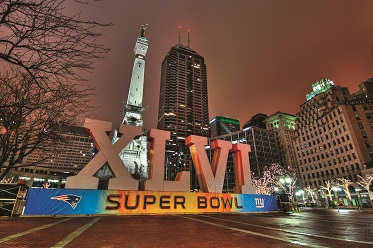 A variety of facilities are available, including Bankers Life Fieldhouse, a retro-styled basketball arena with seating for over 18,000. Just down the street is the Indiana Convention Center. The campus of Indiana University Purdue University Indianapolis (IUPUI) located downtown offers two more sporting venues: the IU Natatorium and the IU Michael A. Carrol Track & Soccer Stadium. Just outside of the downtown core are other facilities, most notably the Indianapolis Motor Speedway, which hosts the Indy 500 as well as NASCAR’s Brickyard 400 and the Red Bull Moto GP motorcycle. Additionally, Eagle Creek State Park has played host to water sports including U.S. Rowing National Championships and NCAA Rowing competitions. A future piece of our infrastructure is a $63 million renovation will help the historic, 8,200-seat Coliseum at the Indiana State Fairgrounds attract a wider variety of sporting events, from basketball and hockey to rodeos.
A variety of facilities are available, including Bankers Life Fieldhouse, a retro-styled basketball arena with seating for over 18,000. Just down the street is the Indiana Convention Center. The campus of Indiana University Purdue University Indianapolis (IUPUI) located downtown offers two more sporting venues: the IU Natatorium and the IU Michael A. Carrol Track & Soccer Stadium. Just outside of the downtown core are other facilities, most notably the Indianapolis Motor Speedway, which hosts the Indy 500 as well as NASCAR’s Brickyard 400 and the Red Bull Moto GP motorcycle. Additionally, Eagle Creek State Park has played host to water sports including U.S. Rowing National Championships and NCAA Rowing competitions. A future piece of our infrastructure is a $63 million renovation will help the historic, 8,200-seat Coliseum at the Indiana State Fairgrounds attract a wider variety of sporting events, from basketball and hockey to rodeos.
Developing the Economic Impact Calculator, Measuring Event Impact
Up until now, we have discussed the segment of Indy's growth that dealt with our formative years, which have led to economic growth. Over the years, hosting all of these events has had a significant impact on Indianapolis. Not only have they elevated the city’s image, but they have also provided substantial economic impact for the region over the years.
How to accurately capture the impact is not a clearly defined calculation and can be a difficult concept to grasp. That is why Visit Indy has turned to expert researchers and economists for assistance. Prior to 2009, Visit Indy used DMAI’s calculator, a well-respected tool in the industry. But in 2009, an outside economist and researcher was commissioned to put together a proprietary calculator tailored for Indy. It was an effort to more accurately capture the spending habits of visitors specific to our destination, taking into account the unique characteristics and design of our city. We did this to convey the benefits of tourism and events we are attracting to the local community. By putting an accurate economic impact dollar amount to these events, the public is more likely to understand why dollars are invested in infrastructure, to attract events, and support organizations like Visit Indy.
A long list of factors makes up the calculation developed specifically for Indianapolis. To estimate visitor spending per attendee, the formula looks at the percentage of attendees arriving by air versus driving in, as well as ground transportation, food, hotel, shopping, and entertainment expenses. To gauge tax revenue, taxes factored in include admissions, corporate income, excise, food and beverage, hotel, other business, personal income, rental car, sales, and social security taxes. To add to the accuracy of estimates, Visit Indy works with event organizers and hoteliers to make adjustments based on hotel room nights, attendance, and follow-up survey results.
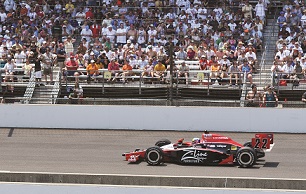
We know that 22 million people visited Indianapolis in 2011, creating an overall economic impact of $3.95 billion and generating $632 million in local and state taxes. Of the $3.95 billion, 66 percent of the impact is being generated by leisure visitors and this includes sporting and special events. The other 34 percent is generated by business, convention and meeting visitors.
The economic impact can be broken down into immediate and long-term, and both are valuable (albeit complex) to calculate. The immediate impact is based on visitor spending, and the long-term benefits exist when attendees at these events see future potential in our city. When business leaders and corporate decision-makers see how vibrant the destination is, they may choose to open a new office or relocate their business, and when they see how well the city executes major events, they may bring their meetings and conventions to Indy.
For example, nearly 60 percent of visitors to the Super Bowl were corporate decision-makers, suites at the Indy 500 are full of business executives, and the NCAA Final Fours often serve as incentive trips. Visitors and fans who have a great time may return for future visits with family and friends. And student-athletes impressed with the city may return here to attend college or enter the workforce.
Calculating the Super Bowl’s Impact
Hosting the Super Bowl was something to which the city’s leaders had devoted time and resources for years, and it finally came to fruition in February 2012 with 10 days of excitement that greatly impacted the city. Super Bowl XLVI drew 116,000 visitors and was watched by a record-breaking 111.3 million television viewers. Successfully hosting the event raised the city’s profile on a national and international level, tripled future convention prospects, and equated to $175.9 million in direct visitor spending, with an additional $148 in indirect and induced impact.
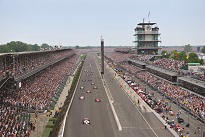 Because of the investment local stakeholders made to host the big game, it was important to deliver an accurate assessment of its economic and fiscal impact. The outside agency was again retained to conduct the study, which isolated spending sources that were Super Bowl-initiated, local to the Indianapolis metro area, and net new to eliminate overstatement of spending that would have taken place anyway. The study excludes benefits such as value of media exposure and future event bookings. To further garner a conservative impact statement, consideration was given to what normal tourism activity would have taken place if the game were not occurring.
Because of the investment local stakeholders made to host the big game, it was important to deliver an accurate assessment of its economic and fiscal impact. The outside agency was again retained to conduct the study, which isolated spending sources that were Super Bowl-initiated, local to the Indianapolis metro area, and net new to eliminate overstatement of spending that would have taken place anyway. The study excludes benefits such as value of media exposure and future event bookings. To further garner a conservative impact statement, consideration was given to what normal tourism activity would have taken place if the game were not occurring.
We consider a visitor anyone who came from over 50 miles away. The average spending per visitor equaled $560 per day on hotels, restaurants, retail, gasoline, ground transportation, and entertainment.
Another important calculation included in the study was that the Super Bowl produced over 224,000 hotel room nights with an average daily room rate of $290. The average daily rate for the same time in 2011 was around $100.
Hosting this high-profile event had other benefits as well not included in the impact calculations, but worth noting. Super Bowl XLVI was the most watched television event in history, and the positive media exposure about Indianapolis’ execution of the event was incredible. The study noted this as an advertising equivalency value of $8.4 million. The effect on future meetings and events was also significant. Visit Indy uses the metric of hotel room-nights booked annually to evaluate sales success, and lead room-nights increased from 390,000 in the first quarter of 2011 to 998,000 in the first quarter of 2012 when the Super Bowl was held.
Looking to the Future
2012 will be a difficult year to top, but the city and its leaders are already planning for what is next. Another Super Bowl? Other major sporting events?

